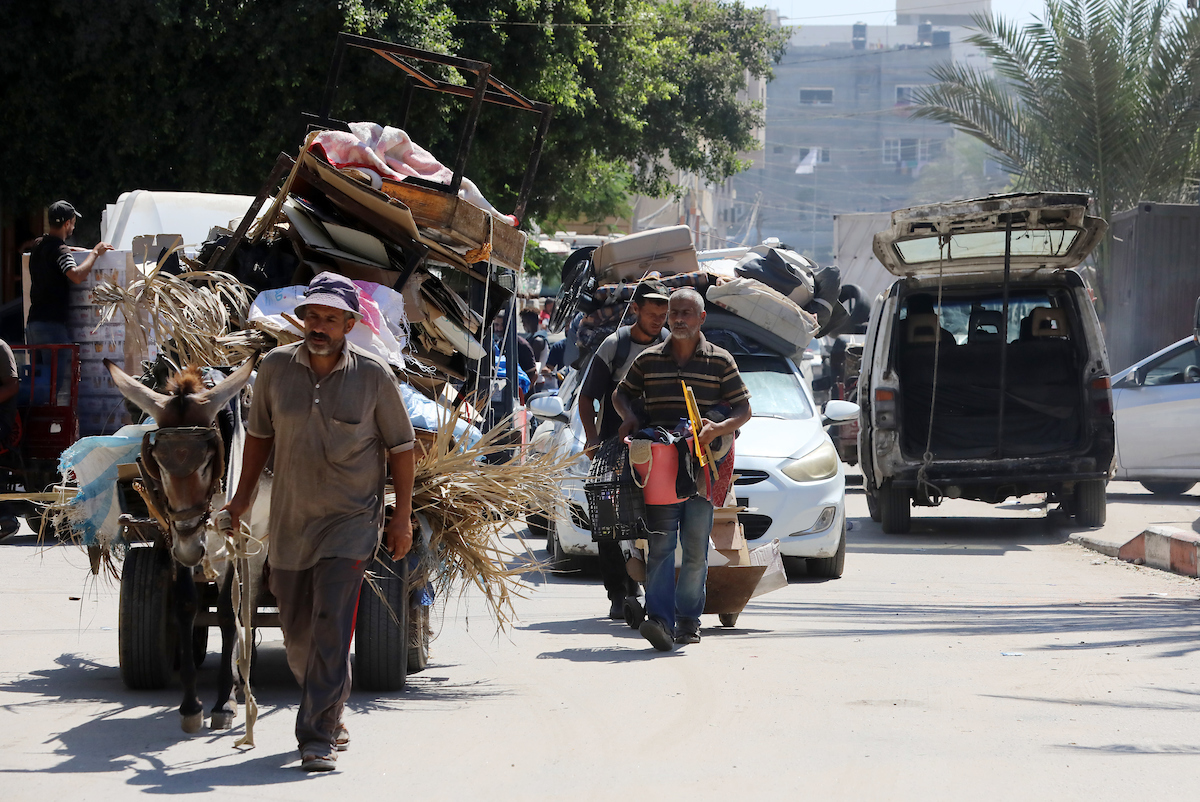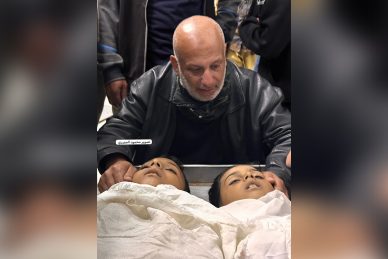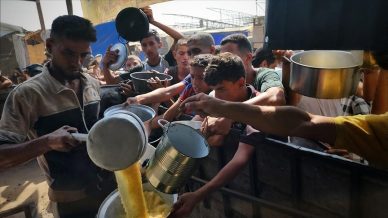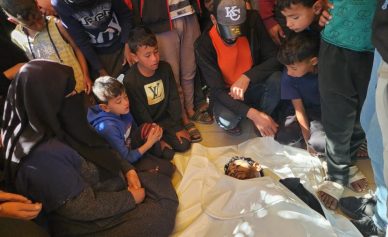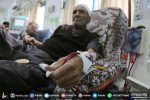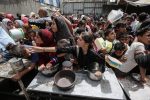GAZA, (PIC)
Under the fire of Israeli drones and artillery bombardment, thousands of Palestinian displaced people were forced to flee from their tents in the Mawasi al-Qirara area in Khan Younis to endure a harsh night, after a series of Israeli forced displacement orders accompanied by intense bombardment.
65-year-old Mahmoud Abdel Ghafour was unable to leave his tent where the Israeli shelling surprised him, injuring him and leaving him bleeding in place until he was martyred, joining his son who was martyred last November.
Hamada Abdel Ghafour told the Palestinian Information Center (PIC) that a relative was martyred in the area where the occupation forces committed a bloody massacre last March, and he indicated that the occupation forces burned many of the tents that had become a refuge for the displaced families from the town of al-Qarara and Al-Satr Al-Gharbi.
Displacement martyrs
According to medical sources, at least 5 Palestinians were martyred as a result of the sudden targeting of the displaced in the Mawasi al-Qarara area, northwest of Khan Yunis, on Wednesday evening, while at least 15 were martyred over the past two days due to the targeting of the displaced civilians around the city of Hamad and the Mawasi al-Qarara.
The occupation forces did not issue displacement orders from this area, but rather surprised the displaced with sudden bombardment and gunfire.
Whenever the Israeli occupation forces advance suddenly towards an area under fire and bombardment, or issue evacuation orders for the residents of the Gaza Strip, they turn their lives into a real hell, as they are forced to leave their homes or what remains of them or their tents and flee to other areas where there is no adequate space.
Sixteen evacuation orders
Between July 1 and August 21, the occupation forces issued at least 16 evacuation orders in the Gaza Strip, leading to the displacement of around 213,000 Palestinians since the beginning of August until August 16, according to Médecins Sans Frontières (Doctors Without Borders).
Aziza Salem told the PIC, “We fled under gunfire, we took refuge in the sea shore, I and my children spent the night in the open like hundreds, there is nowhere for us to go, they forced us to displace towards Al-Mawasi and they are cutting it off and demanding the evacuation of part of it, where do we go?”
According to the United Nations Office for the Coordination of Humanitarian Affairs, evacuation orders were imposed on 86% of Gaza (this is a statistic prior to the latest evacuation orders that targeted areas in Deir Al-Balah and Khan Yunis) since the start of the Israeli genocidal war, and around 2 million Palestinians suffered from it, most of whom were displaced multiple times.
Evacuation orders start with calls to the residents and sending them messages, before an announcement is issued by the coordinator and the spokesman of the occupation army, accompanied by a map showing the neighborhoods and areas required to be evacuated.
When will the war end?
Khamis Amir, a radio operator with Médecins Sans Frontières (Doctors Without Borders), who was displaced due to an evacuation order on August 21, says, “My family and I demount the tent and pack our belongings [to move]. My children gather their toys and belongings so they don’t get lost. We don’t know where to go. When will this war end?”
Deir Al-Balah in the targeting spotlight
The Euro-Med Human Rights Monitor warned of the danger of the illegal evacuation orders issued by the Israeli army in both Deir Al-Balah in the center of the Gaza Strip, and Al-Mawasi in the west of Khan Yunis in the south of the Strip, which mean imposing further forced displacement and narrowing the space where about 2 million people are crowded.
The Euro-Med Monitor said in a statement that the successive illegal evacuation orders issued by the Israeli army, the latest of which was on Wednesday morning, which called on all civilians, including the forcibly displaced, present in blocks 129, 130 in the Al-Mahatta area and Deir Al-Balah in the south, an area that includes tens of thousands of residents and is near the Martyrs of Al-Aqsa hospital, and the previous illegal evacuation orders that targeted the residents of eastern and southern Deir Al-Balah, indicate that Israel is determined to expand its offensive in the densely populated Deir Al-Balah, which hosts about half of the Gaza Strip’s population, most of whom are displaced from the north and south of Gaza.
Deir Al-Balah currently hosts about half of the Gaza Strip’s population who were forced to flee and escape from various parts of the Gaza Strip, especially from the north of Gaza and Rafah, due to the deliberate aerial, ground and naval bombardment, which targeted entire residential gatherings and targeted shelters, hospitals and civilian public and private facilities, coupled with military orders calling on the population to head south to Deir Al-Balah or “Al-Mawasi”, which are currently being targeted by illegal evacuation orders and bombardment.
Inhumane displacement
Jacob Grange, a project coordinator for Médecins Sans Frontières, says, “The continued forced displacement of people is inhumane. People have lost their possessions and have nowhere to go. There is no place to pitch tents. Overcrowding and severe water and sanitation shortages lead to the spread of disease. We are unable to keep up with the enormous needs.”
The Euro-Med Human Rights Monitor emphasizes that the Israeli army’s reduction of what it calls the humanitarian area by unlawfully targeting wide swaths of it for evacuation, as happened in Mawasi Al-Qararah and Deir Al-Balah, demonstrates that Israel is seeking to herd nearly two million people into an ever-shrinking strip, to the point that population density in the area is unprecedented globally, at a time when the displaced find no place to pitch their tents.
It mentions that many local and international humanitarian institutions have their headquarters in Deir Al-Balah, and the escalation of the attack on the city puts partial humanitarian work at risk of suspension, meaning more existential risks for the residents of the Gaza Strip.
Deprivation of security
According to the Euro-Mediterranean Human Rights Monitor, tracing the methodology of the Israeli bombardment and the unlawful evacuation orders indicates a clear policy aimed at depriving the entire Gaza Strip of security and depriving Palestinians of even momentary shelter or stability, through the continued bombardment across the Strip and the focus on targeting shelters, including those established in UNRWA (United Nations Relief and Works Agency for Palestine Refugees in the Near East) schools, alongside the evacuation orders.

